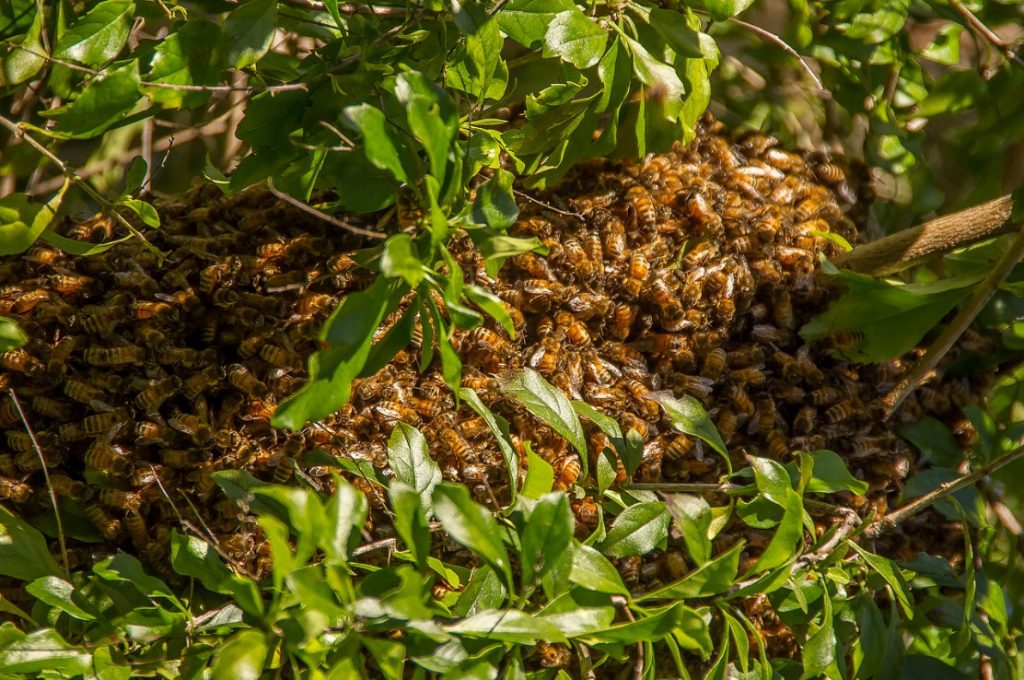
What to do if you find a swarm
If you see a swarm cluster, please contact the nearest collector immediately from the list below. Bees in a swarm state are usually fairly gentle but for your own safety, please stay at a safe distance and keep children and pets away.
Guildford Beekeepers Association will collect swarms to protect the bees and keep the public safe.
This service is free of charge.
However, we are continually raising funds to enhance our existing Training Apiary and develop it into a Sustainable Beekeeping Centre to support our local bee populations, and create a place where local schools and community groups can experience beekeeping first-hand.
If you would like to help us achieve our aims, any donation, large or small, is most welcome and very much appreciated.
Please be aware that any assistance given by a beekeeper is provided on the basis that neither Guildford Beekeepers Association nor its members can be held responsible for any inadvertent damage or injury to property or persons during the process of collecting swarms.
Swarms will be collected subject to the collector doing an accessibility and risk assessment on behalf of the public and themselves.
The Swarming process
Honeybees are social insects that have evolved over millions of years, alongside flowering plants.
Consider the honeybee colony as a superorganism that naturally reproduces by the process of division. They do this by producing a swarm.
Swarms are typically created during the Spring and early Summer seasons when there is an abundance of forage around to give them a chance for survival.
As they are out in the open, a swarm is in a vulnerable state and its survival is uncertain.
The swarm needs to find a suitable new home that will protect it from the elements as soon as possible so that they can create a new nest, establish a new colony and create a new generation of bees that can gather sufficient stores to sustain them through the coming winter.
A viable swarm consists of a queen, and a large number of worker bees that split away from the original colony and fly off together in search of a new home.
The swarm leaves behind a new queen or queen cell with sufficient brood and bees to begin the cycle again.
The departing swarm flies a moderate distance from the original nest site and congregate into a cluster on a convenient branch or accessible structure.
Scout bees are then sent out to find a suitable new location which may not be suitable or convenient for humans such as in a chimney, a wall cavity or in the eaves of a roof.



| Postcode Covered | Area Covered | Name | Contact Number |
|---|---|---|---|
| GU1 | Guildford Area | Sara Cannell | 07552 629084 |
| GU1 | Guildford, Burpham, Merrow | Alastair Heslop | 07599 221890 |
| GU1 | Guildford and Woking | Steve Cotney | 07788 144332 |
| GU1 | Guildford Area | Chris Roberts | 07786 394801 |
| GU3 | Normandy | Lou Major | 07999 525510 |
| GU4 | Guildford / Shalford | Peter Smith | 07534 919121 |
| GU5 | Bramley Area | Steve Cotney | 07788 144332 |
| GU6 | Cranleigh Area | Jonathan Brookhouse | 07768 376265 |
| GU10 | Farnham Area | Val Holditch | 07779 670631 |
| GU12 | Ash Green Area | Astrid Bowers-Veenman | 07803 069798 |
| GU15 | Camberley, Lightwater, Frimley | Mark Scott | 07702 500972 |
| GU24 | West End, Lightwater, Bisley | Greg Reeve | 07876 575671 |
| GU24 | Bisley Area | Jonathan Pegg | 07947 613673 |
| GU24 | Brookwood, Pirbright Area | Lou Major | 07999 525510 |
| KT24 | Horsley Area | David Bennett | 07818 026044 |
 Your Location
Your Location